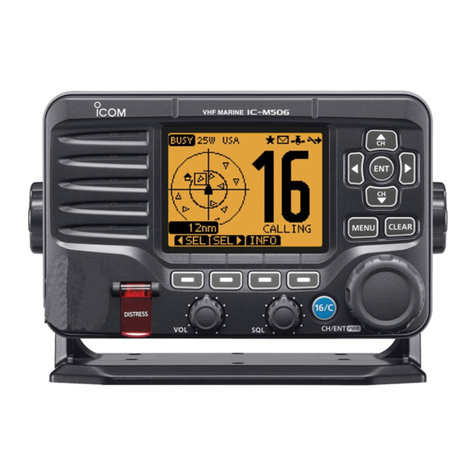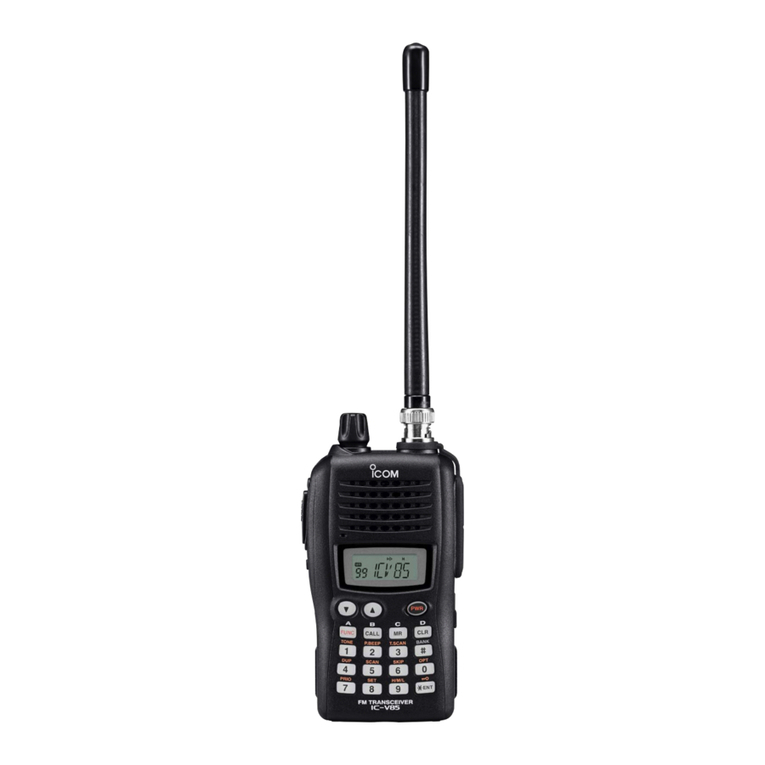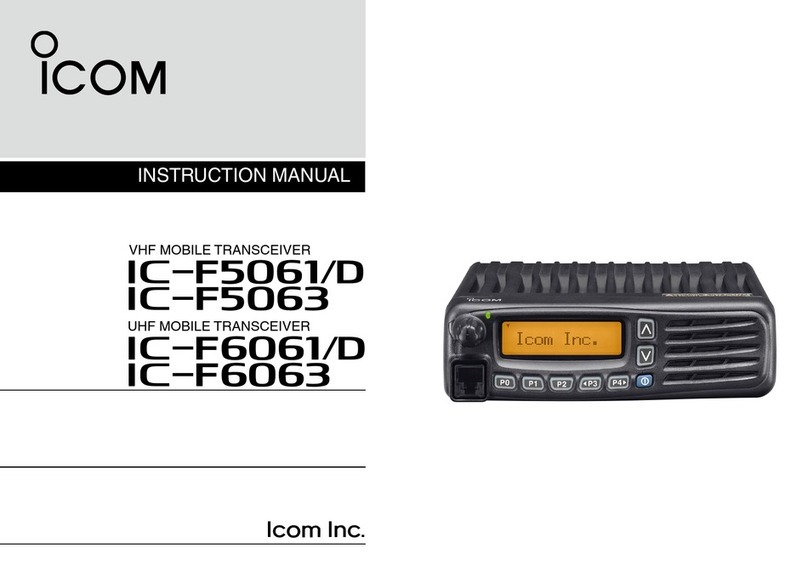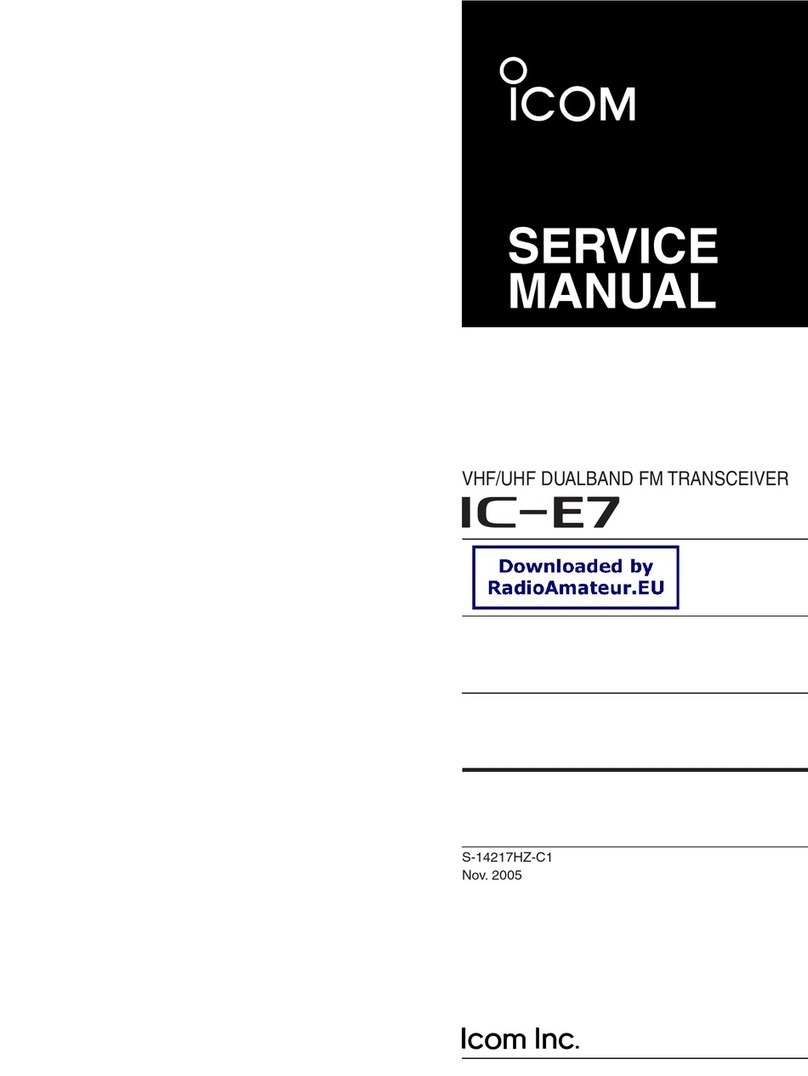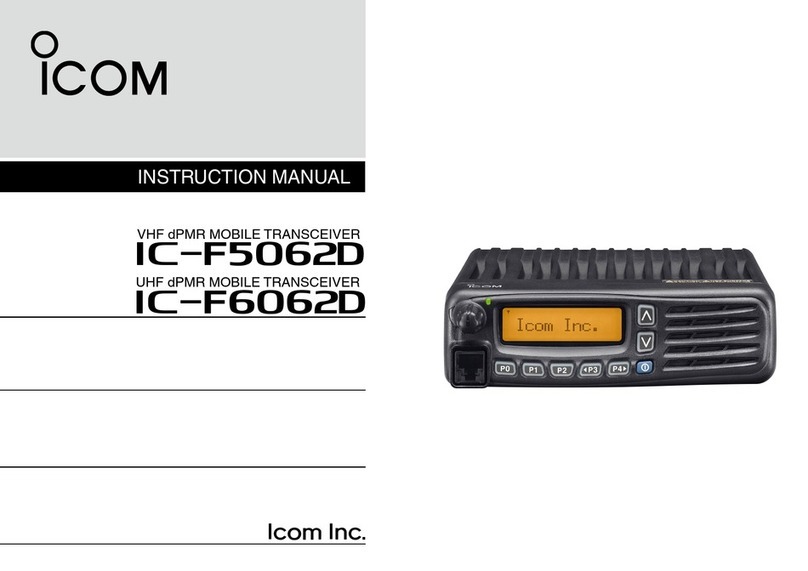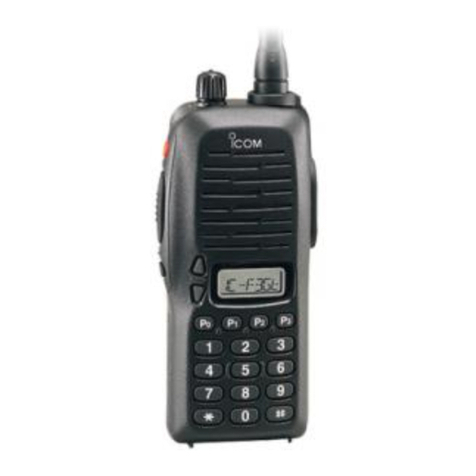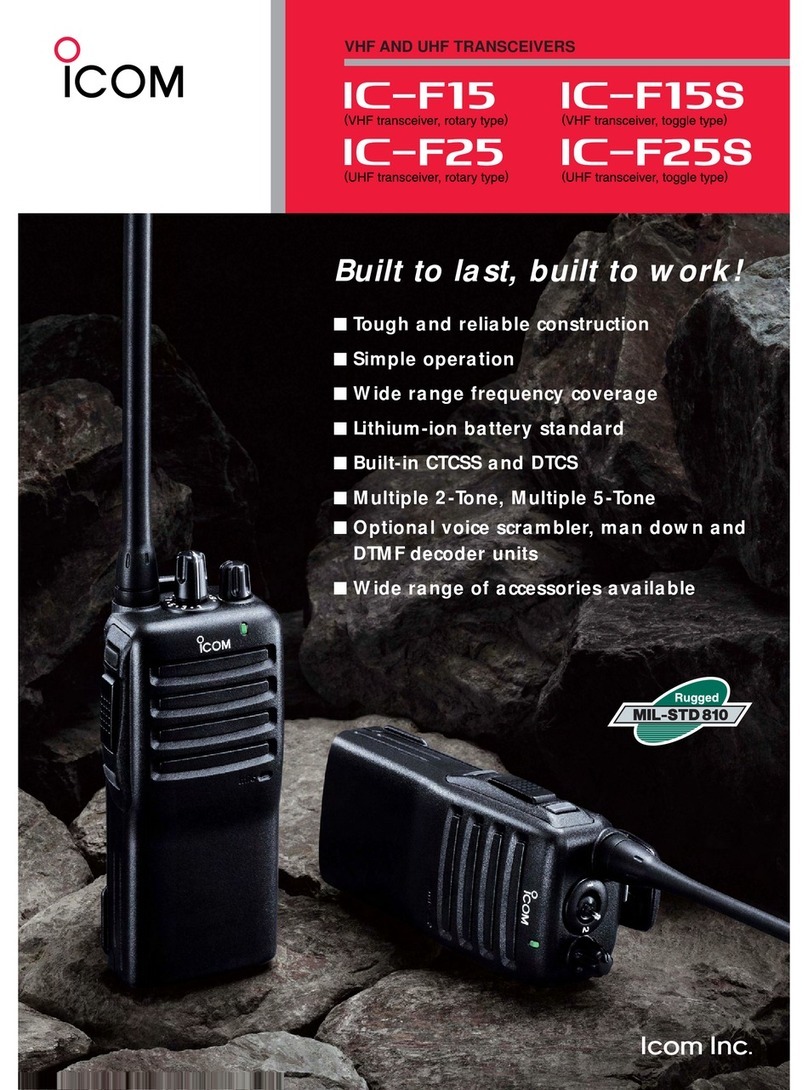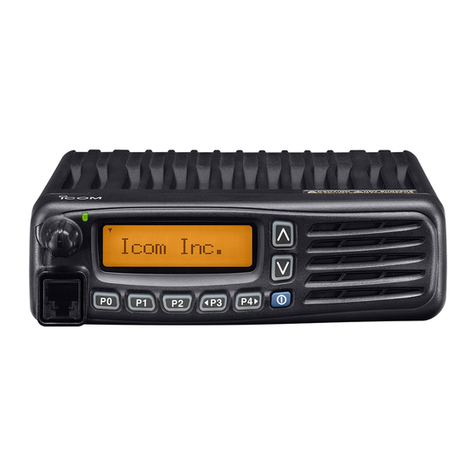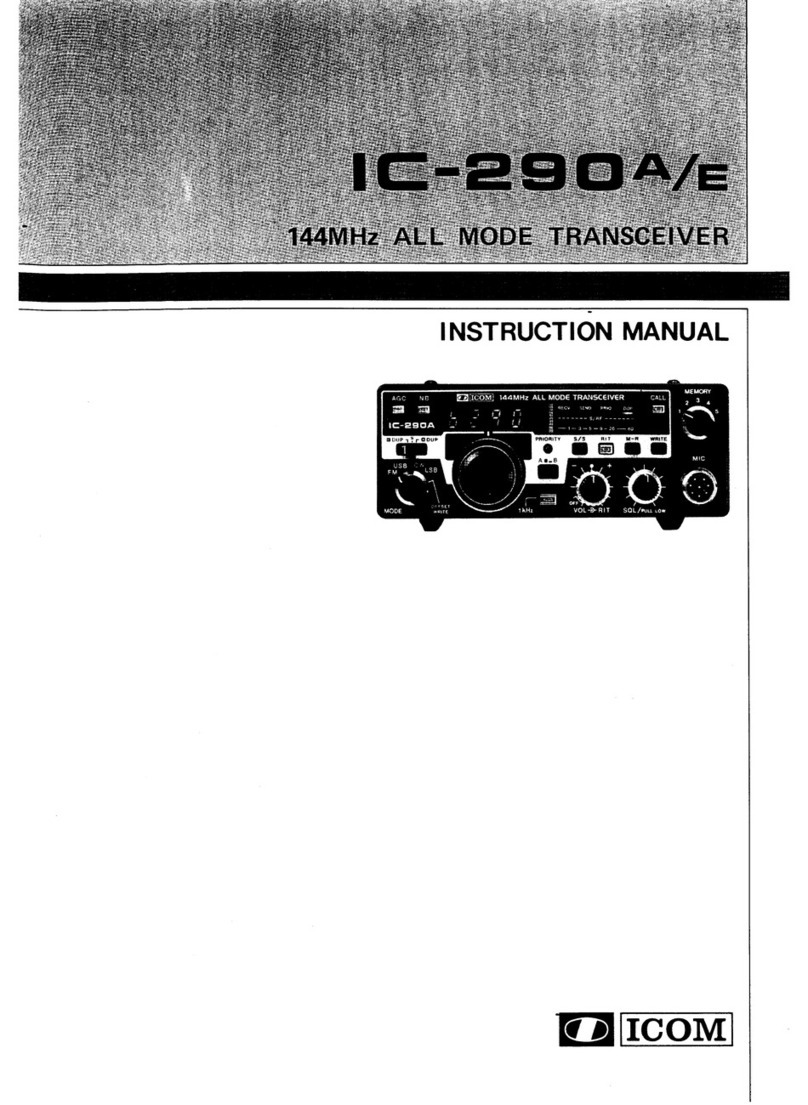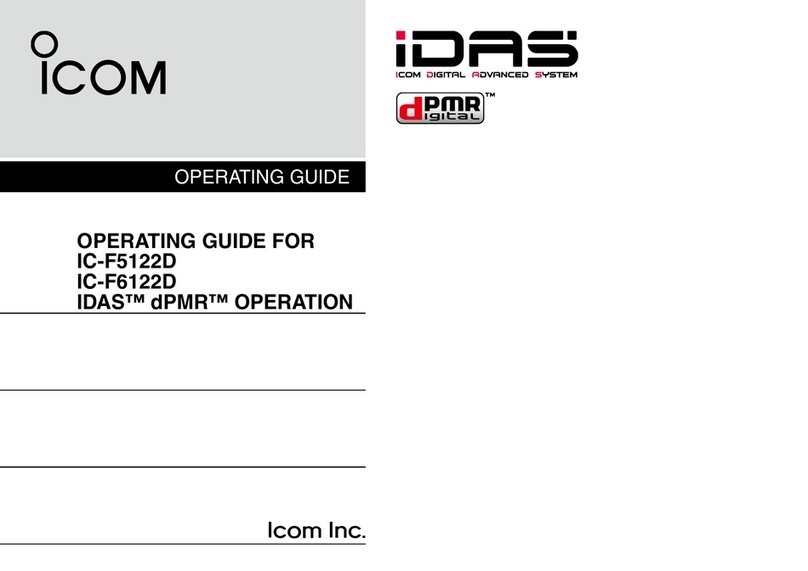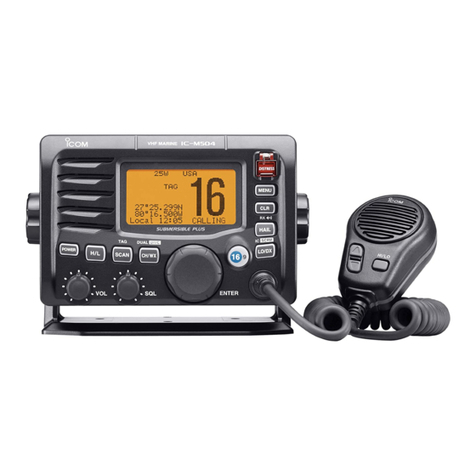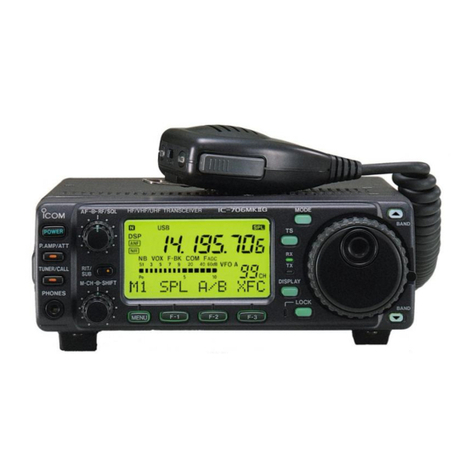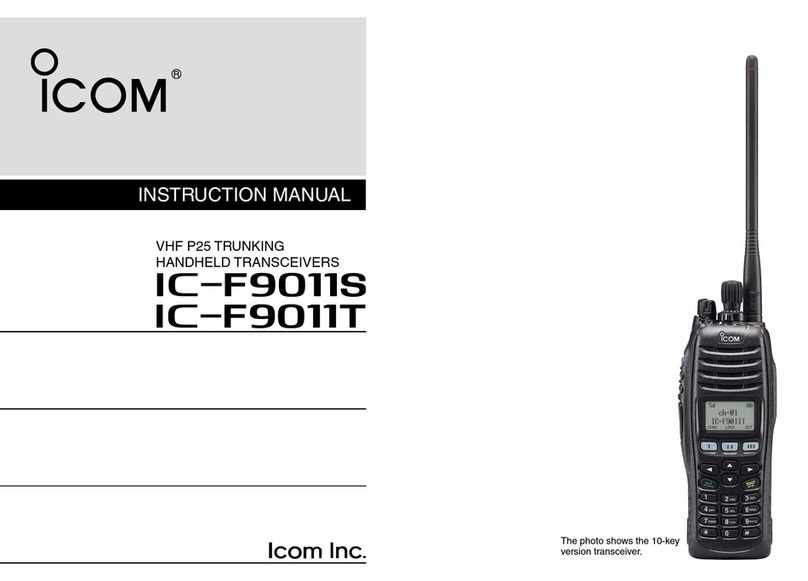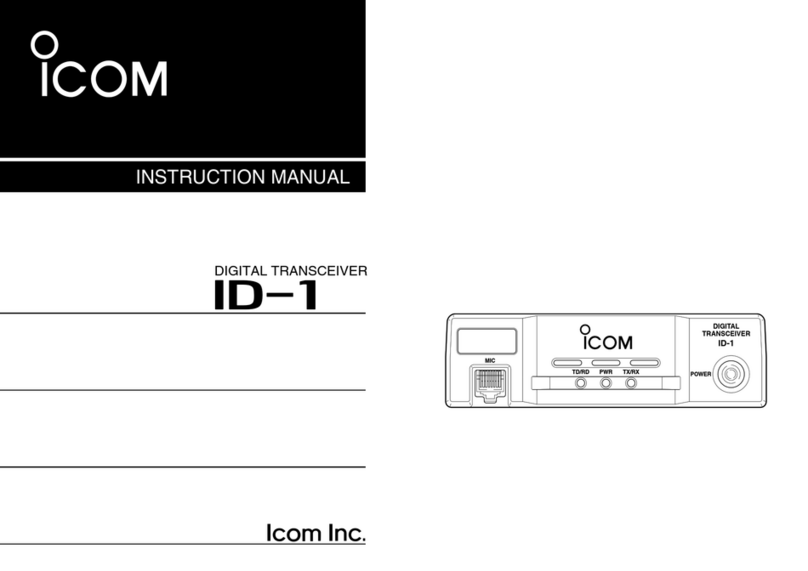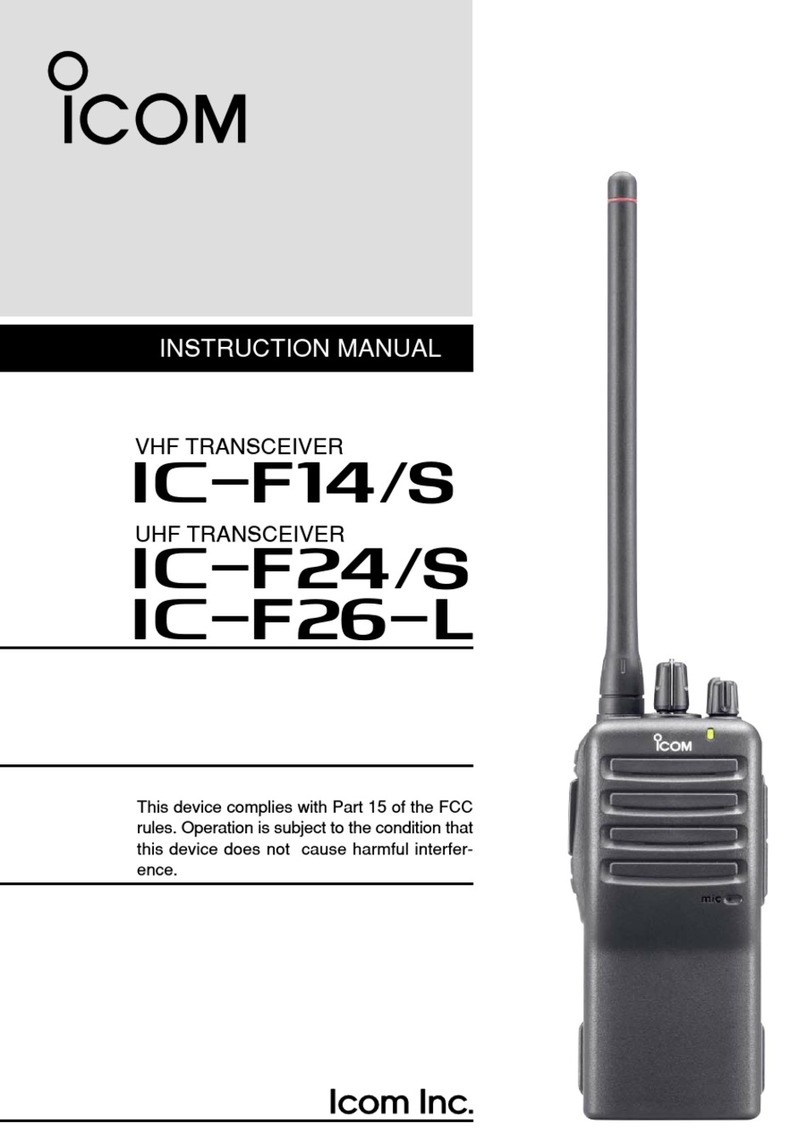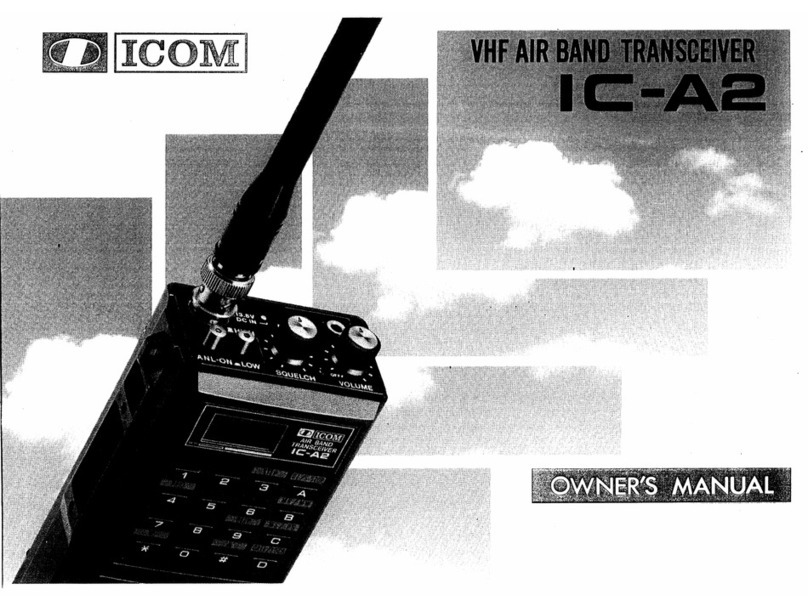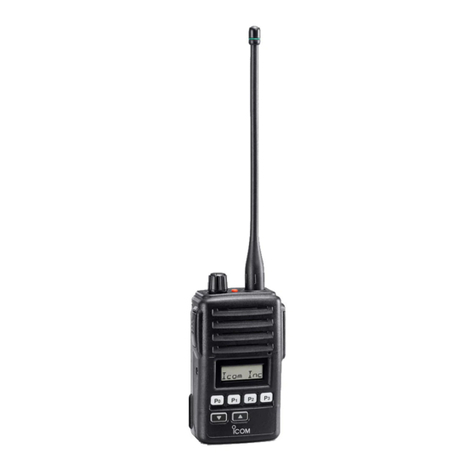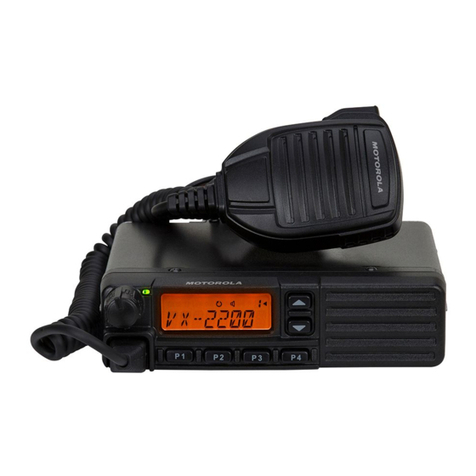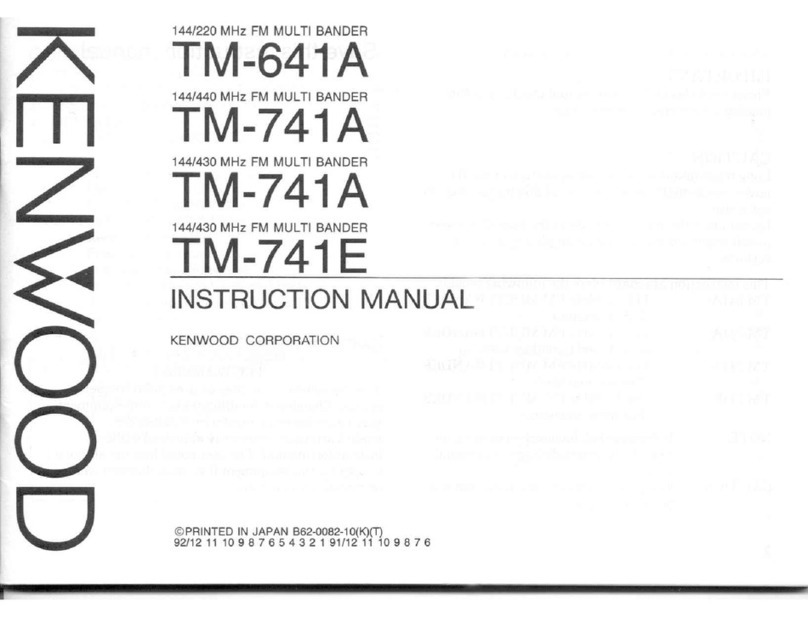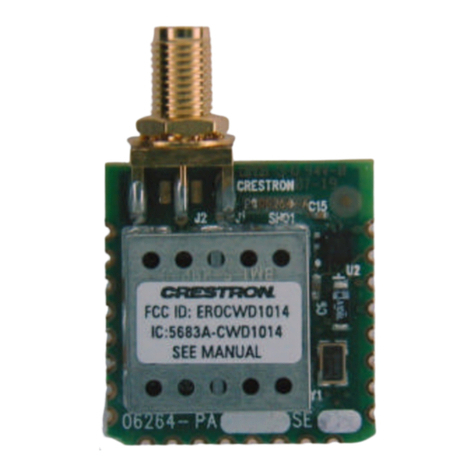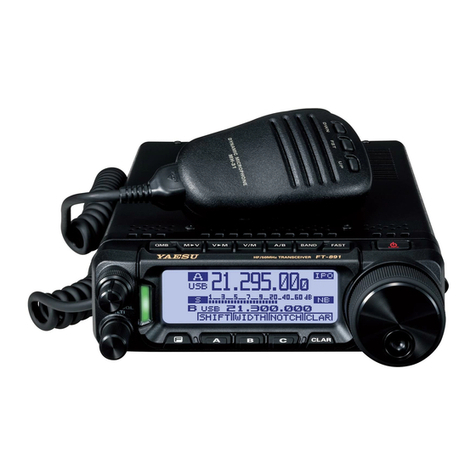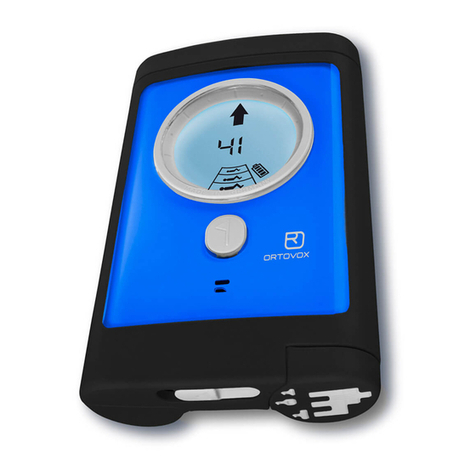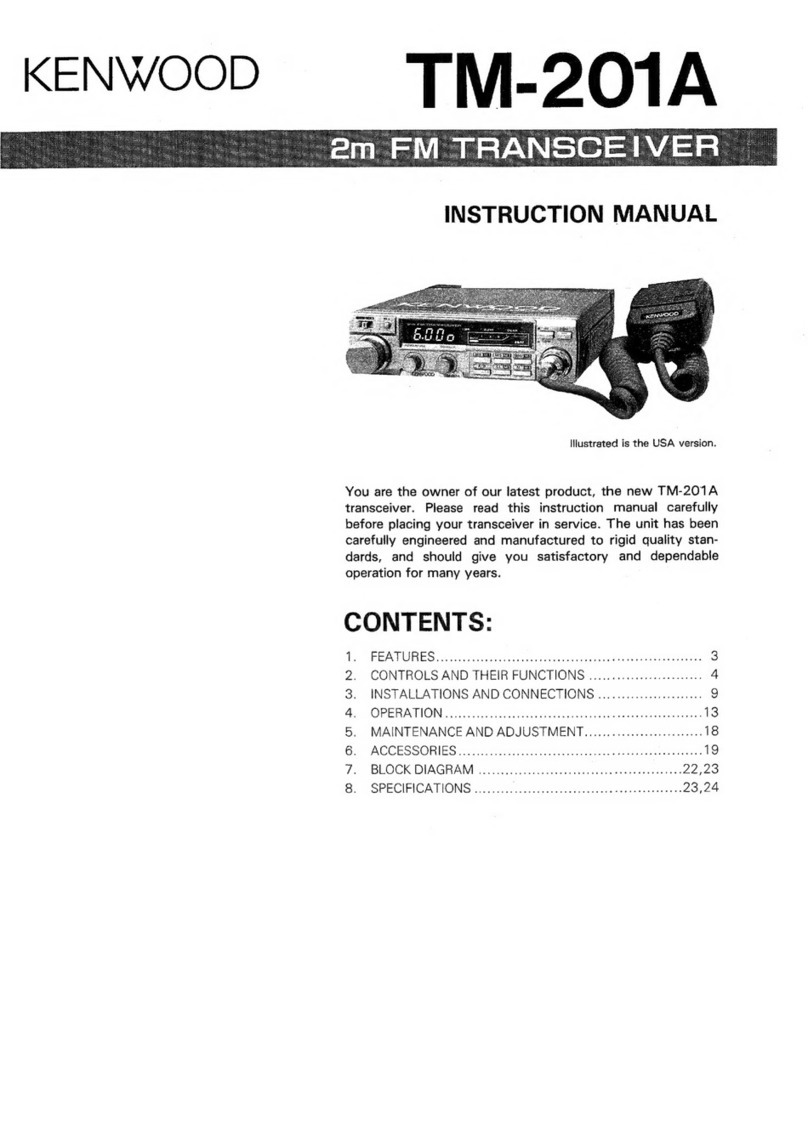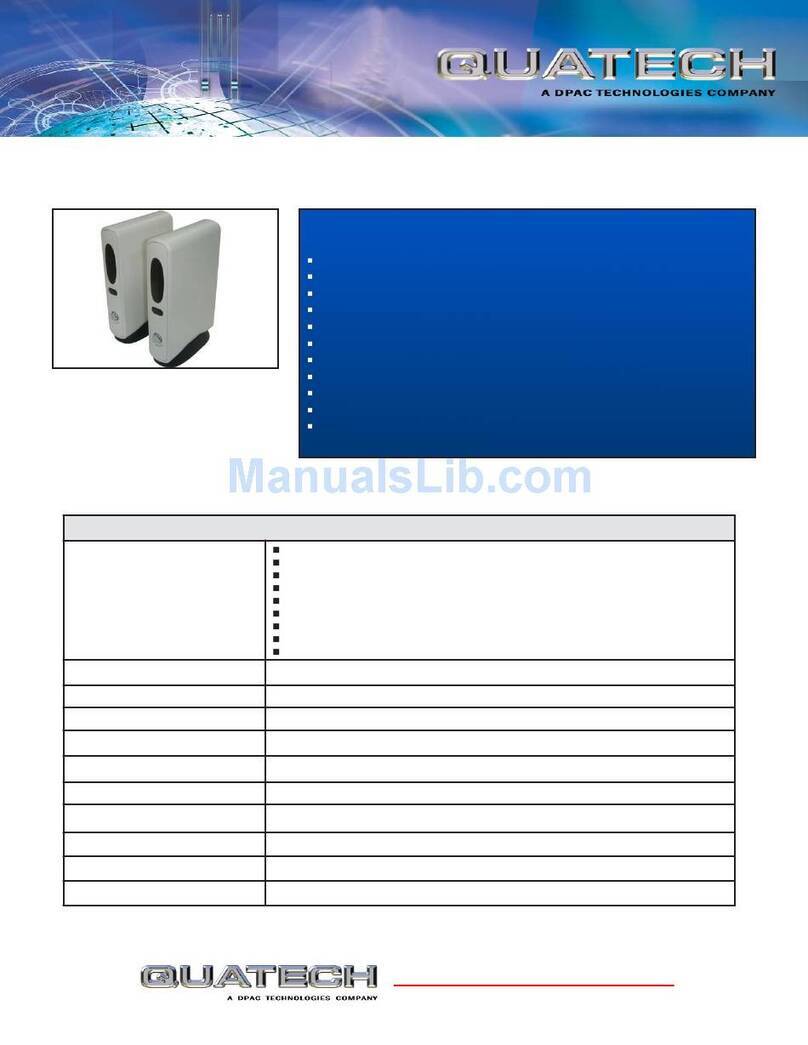Icom IC-F3062T User manual

INSTRUCTION MANUAL
iF4062T/S
UHF TRANSCEIVER
iF3062T/S
VHF TRANSCEIVER

i
IMPORTANT
READ ALL INSTRUCTIONS carefully and com-
pletely before using the transceiver.
SAVE THIS INSTRUCTION MANUAL— This
instruction manual contains important operating instructions
for the IC-F3062T and IC-F3062S VHF TRANSCEIVERS and
IC-F4062T and IC-F4062S UHF TRANSCEIVERS.
Icom, Icom Inc. and the Icom logo are registered trademarks of Icom
Incorporated (Japan) in Japan, the United States, the United King-
dom, Germany, France, Spain, Russia and/or other countries.
EXPLICIT DEFINITIONS
WORD DEFINITION
RDANGER! Personal death, serious injury or an ex-
plosion may occur.
RWARNING! Personal injury, fire hazard or electric
shock may occur.
CAUTION Equipment damage may occur.
NOTE
If disregarded, inconvenience only. No risk
of personal injury, fire or electric shock.
PRECAUTIONS
RDANGER! Use and charge only specified Icom battery
packs with Icom radios or Icom chargers. Only Icom battery
packs are tested and approved for use with Icom radios or
charged with Icom chargers. Using third-party or counterfeit
battery packs or chargers may cause smoke, fire, or cause
the battery to burst.
RWARNING! NEVER hold the radio so that the an-
tenna is very close to, or touching exposed parts of the body,
especially the face or eyes, while transmitting. The radio will
perform best if the microphone is 5 to 10 cm away from the
lips and the radio is vertical.
RWARNING! NEVER operate the radio with a headset
or other audio accessories at high volume levels. The con-
tinuous high volume operation may cause a ringing in your
ears. If you experience the ringing, reduce the volume level
or discontinue use.
RWARNING! NEVER operate the radio while driving
a vehicle. Safe driving requires your full attention—anything
less may result in an accident.

1
2
3
4
5
6
7
8
9
10
11
12
13
14
15
16
ii
PRECAUTIONS
CAUTION: MAKE SURE the flexible antenna and bat-
tery pack are securely attached to the radio, and that the an-
tenna and battery pack are dry before attachment. Exposing
the inside of the radio to water will result in serious damage
to the radio.
DO NOT operate the radio near unshielded electrical blast-
ing caps.
DO NOT push [PTT] when you do not actually intend to
transmit.
DO NOT operate or place the radio in direct sunlight or in
areas with temperatures below –25°C or above +55°C.
DO NOT modify the radio. The specifications may change
and then not comply with the requirements of a corresponded
regulation. The radio warranty does not cover any problems
caused by unauthorized modification.
DO NOT use harsh solvents such as benzine or alcohol
when cleaning, as they will damage the radio surfaces.
KEEP the transceiver from the heavy rain, and Never im-
merse it in the water. The transceiver construction is water
resistant, not waterproof.
BE CAREFUL! The radio will become hot when operating
it continuously for long periods of time.
Even when the radio power is OFF, a slight current still flows
in the circuits. Remove the battery pack or batteries from
the radio when not using it for a long time. Otherwise, the in-
stalled battery pack or batteries will become exhausted, and
will need to be recharged or replaced.
MAKE SURE to turn OFF the radio power before connect-
ing or disconnecting the supplied/optional equipment.

iii
TABLE OF CONTENTS
IMPORTANT.......................................................................... i
EXPLICIT DEFINITIONS....................................................... i
PRECAUTIONS..................................................................... i
TABLE OF CONTENTS....................................................... iii
1 ACCESSORIES ...........................................................1–3
Supplied accessories■...................................................1
Accessory attachments■................................................1
2 PANEL DESCRIPTION..............................................4–10
Front panel■...................................................................4
Function display■...........................................................6
Programmable function keys■........................................7
3 BASIC OPERATION................................................11–16
Turning power ON■......................................................11
Channel selection■......................................................12
Call procedure■............................................................12
Receiving and transmitting■.........................................13
User set mode■............................................................16
Scrambler function■.....................................................16
4 BIIS OPERATION ....................................................17–27
Setting example■.........................................................17
Receiving a call■..........................................................17
Transmitting a call■......................................................19
Receiving a message■.................................................21
Transmitting a status■..................................................23
Transmitting an SDM■(Short Data Message) .................24
Position data transmission■.........................................25
Printer connection■......................................................26
Digital ANI■..................................................................26
Auto emergency transmission■....................................26
Stun function■..............................................................26
BIIS indication■............................................................27
Priority A channel selection■........................................27
5 BATTERY CHARGING ............................................28–32
Caution■.......................................................................28
Optional battery chargers■...........................................30
6 BATTERY CASE............................................................33
Optional battery case (BP-240)■..................................33
7 SWIVEL BELT CLIP ................................................34–35
MB-93 contents■..........................................................34
Attaching■....................................................................34
Detaching■...................................................................35
8 SPEAKER MICROPHONE............................................36
Optional HM-169/170GP description■.........................36
To attach■....................................................................36
9 OPTIONS.................................................................37–40
10 COUNTRY CODE LIST .................................................41

1
1
ACCESSORIES
1
Supplied accessories■
The following accessories are supplied: Qty.
Flexible antennaq.............................................................. 1
Battery packw.................................................................... 1
Belt clipe........................................................................... 1
Connector cover (with screw)r.................................... 1 set
qwe
r
Accessory attachments■
Flexible antennaD
Connect the supplied flexible anten-
na to the antenna connector.
CAUTION:
• NEVER carry the transceiver by
holding only the antenna.
• DO NOT connect the antenna
other than listed on page 38.
• Transmitting without an antenna
will damage the transceiver.

2
1ACCESSORIES
Battery packD
To attach the battery pack:
Slide the battery pack on the back of the transceiver in the direc-
tion of the arrow (q), then lock it with the battery release button.
• Slide the battery pack until the battery release button makes a ‘click’
sound.
To remove the battery pack:
Push the battery release button in the direction of the arrow
(w) as shown below. The battery pack is then released, and
you can remove it.
NEVER remove or attach the battery pack when the trans-
ceiver is wet or soiled. This may result water or dust getting
into the transceiver/battery pack and may result in the
transceiver being damaged.
q
w
Battery release
button
Battery pack
NOTE: Keep the battery pack terminals clean. It’s a good
idea to occasionally clean them.
Belt clipD
To attach the belt clip:
Remove the battery pack if it is attached.q
Slide the belt clip in the direction of the arrow until the beltw
clip is locked and makes a ‘click’ sound.
To detach the belt clip:
Remove the battery pack if it is attached.q
Pinch the clip (wq), and slide the belt clip in the direction of
the arrow (w).
q
w

3
1
ACCESSORIES
1
Connector cover
D
To attach the connector cover:
qInsert the connector cover into the multi-connector.
wTighten the screw.
q
w
Multi-
connector
Connector
cover
CAUTION:
Attach the connector cover when the optional speaker-
microphone is not used.
Otherwise the terminals of the multi-connector may be
shorted by metal object, etc., and this could damage the
transceiver.
To detach the connector cover:
qUnscrew the screw using a phillips screwdriver.
wDetach the connector cover for the speaker-microphone or
head-set connector.
q
w

4
2PANEL DESCRIPTION
Front panel
■
w
e
t
r
y
q
!1
!0
o
!2
ui
Microphone
Speaker
qROTARY SELECTOR
Rotate to select the pre-programmed memory channels or
the operating zone.
(Depending on the pre-setting)
wANTENNA CONNECTOR
Connects the supplied antenna.
eDEALER-PROGRAMMABLE KEY [Emer]
Desired functions can be programmed by your dealer.
((☞p. 7))
rDEALER-PROGRAMMABLE KEY [Side1]
Desired functions can be programmed by your dealer.
((☞p. 7))
tPTT SWITCH [PTT]
Push and hold to transmit; release to receive.
yDEALER-PROGRAMMABLE KEYS [Side2]/[Side3]
Desired functions can be programmed independently by
your dealer. ((☞p. 7))
u10-KEYPAD (Depending on version)
The keypad allows you to enter digits to:
• Select memory channels
• Select tone channels
• Select DTMF codes (during transmit)
• Set TX codes
• Set BIIS status number
• Input text message for SDM operation.
• Start up with the password

5
2
PANEL DESCRIPTION
2
iDEALER-PROGRAMMABLE KEYS [P0] to [P3]
Desired functions can be programmed independently by
your dealer. ((☞p. 7))
oFUNCTION DISPLAY
Displays a variety of information such as an operating
channel number/name, 2/5-tone code, DTMF numbers,
selected function, etc.
!0 MULTI-CONNECTOR
Connect an optional speaker-microphone.
Connector cover
NOTE: Attach the
connector cover when
the optional speaker-
microphone is not used.
See ((� p. 3)) for details.
!1 BUSY/TRANSMIT INDICATOR
➥ Lights green while receiving a signal, or when the
squelch is open.
Lights red while transmitting.➥
!2 VOLUME CONTROL [VOL]
Rotate to turn the power ON/OFF and adjusts the audio
level.

6
2PANEL DESCRIPTION
Function display
■
SET
CALA TXCU
TXC
q t iuyrew
o
!0
qSIGNAL STRENGTH INDICATOR
Indicates relative signal strength level.
wLOW POWER INDICATOR
Appears when low output power is selected.
eAUDIBLE INDICATOR
Appears when the channel is in the ‘audible’ (unmute) ➥
condition.
Appears when the specified 2/5-tone/BIIS code is re-➥
ceived.
r COMPANDER INDICATOR
Appears when the compander function is activated.
t SCRAMBLER INDICATOR
Appears when the voice scrambler function is activated.
y BELL INDICATOR
Appears/blinks when the specific 2/5-tone/BIIS code is re-
ceived, according to the pre-programming.
u CALL CODE MEMORY INDICATOR
Appears when the call code memory is selected.
i BATTERY INDICATOR
Indicates remaining battery power.
Indication
Full Middle Charging
required No battery
Battery level
blinks when the battery is exhausted.
blinks when the battery is over voltage.
o ALPHANUMERIC DISPLAY
Displays an operating channel number, channel name,➥
Set mode contents, DTMF code, etc.
The indication mode can be selected from 1 line or 2➥
lines. Ask your dealer for details.
• In this instruction manual, the LCD illustration is described
using the 2 lines indication mode.
!0 KEY INDICATOR
Indicate the programmed function of the front panel keys
([P0], [P1], [P2] and [P3]).

7
2
PANEL DESCRIPTION
2
Programmable function keys
■
The following functions can be assigned to [Emer],[Side1],
[Side2], [Side3], [P0], [P1], [P2] and [P3] programmable
function keys.
Consult your Icom dealer or system operator for details con-
cerning your transceivers programming.
If the programmable function names are bracketed in the fol-
lowing explanations, the specific key is used to activate the
function depends on the programming.
CH UP AND DOWN KEYS “UP” “DOWN”
Push to select an operating channel.➥
Push to select a transmit code channel after pushing [TX➥
Code CH Select].
Push to select a DTMF channel after pushing [DTMF Au-➥
todial].
Push to select a scan group after pushing and holding➥
[Scan A Start/Stop]/[Scan B Start/Stop].
Push to select a BIIS code, status number or SDM after➥
pushing [Digital Button].
ZONE KEY “ZONE”
Push this key, then push [CH Up] or [CH Down] to select the
desired zone.
What is “zone”?— The desired channels are assigned
into a zone according to the intended use for grouping. For
example, ‘Staff A’ and ‘Staff B’ are assigned into a “Busi-
ness” zone, and ‘John’ and ‘Cindy’ are assigned into a “Pri-
vate” zone.
SCAN A KEY “SCNA”
This key’s operation depends on the Power ON Scan set-➥
ting.
When the power ON scan function is turned OFF;
Push to start and cancel scanning operation. In case of
transmission during scan, cancels scanning.
When the power ON scan function is turned ON;
Push to pause scanning., then resumes scanning after
passing a specified time period. In case of transmission
during scan, scanning will be cancelled.
Push and hold this key for 1 sec. to indicate the scan➥
group, then push [CH Up] or [CH Down] to select the de-
sired group.
SCAN B KEY “SCNB”
Push to start and cancel scanning operation. In case of➥
transmission during scan, pauses scanning. Scanning re-
sumes after passing a specified time period.
Push and hold this key for 1 sec. to indicate the scan➥
group, then push [CH Up] or [CH Down] to select the de-
sired group.

8
2PANEL DESCRIPTION
SCAN ADD/DEL (TAG) KEY “SCAD”
Push to add or delete the selected channel to/from the scan
group.
PRIO A/B KEYS “PRA” “PRAR” “PRB” “PRBR”
Push to select Priority A or Priority B channel.➥
Push and hold [Prio A (Rewrite)] to rewrite the Prio A➥
channel.
MR-CH 1/2/3/4 KEYS “CH1” “CH2” “CH3” “CH4”
Push to select an operating channel directly.
MONI (AUDI) KEY “MON”
Activates one of (or two of) the following functions on➥
each channel independently: (PMR or BIIS PMR opera-
tion only)
• Push and hold to un-mute the channel (audio is emitted; ‘Audible’
condition).
• Push to mute the channel (sets to ‘Inaudible’ only).
• Push to un-mute the channel (sets to ‘Audible’ only).
• Push after the communication is nished to send a ‘reset code.’
NOTE: The un-mute condition (‘Audible’ condition) may
automatically return to the mute condition (‘Inaudible‘ con-
dition) after a specified period depending on program-
ming.
LIGHT KEY “LIGT”
Push to turn the transceiver’s backlight ON temporarily only
when the backlight function is turned OFF in user set mode.
LOCK KEY “LOCK”
Push and hold for 1 sec. to electronically lock all program-➥
mable keys except the following:
[Call] (incl. Call A and Call B), [Moni(Audi)] and [Emergen-
cy].
Push and hold for 1 sec. again to turn the lock function➥
OFF.
HIGH/LOW KEY “H/L”
Push to select the transmit output power temporarily or per-
manently, depending on the pre-setting.
• Ask your dealer for the output power level for each selection.
C.TONE CH ENT KEY “TSEL”
Push to select the continuous tone channel using [CH Up]/
[CH Down] to change the tone frequency/code setting. The
selected channel remains set as the continuous tone channel
until another channel is designated as such.
TALK AROUND KEY “TA”
Push to turn the talk around function ON and OFF.
• The talk around function equalizes the transmit frequency to the
receive frequency for transceiver-to-transceiver communication.
WIDE/NARROW KEY “W/N”
Push to toggle the IF bandwidth between wide and narrow.
• The wide passband width can be selected from 25.0 or 20.0 kHz us-
ing the CS-F3060 c l o n i n g s o f t wa r e . (PMR or BIIS PMR operation
only) Ask your Dealer for details.

9
2
PANEL DESCRIPTION
2
DTMF AUTODIAL KEY “DTMA”
Push to enter the DTMF channel selection mode.Then se-➥
lect the desired DTMF channel using [CH Up]/[CH Down].
After selecting the desired DTMF channel, push this key to➥
transmit the DTMF code.
RE-DIAL KEY “DTMR”
Push to transmit the last-transmitted DTMF code.
CALL KEYS “CALL” “CALA” “CALB”
Push to transmit a 2/5-tone/BIIS ID code.
• Call transmission is necessary before you call another station de-
pending on your signaling system.
• [Call A] and/or [Call B] may be available when your system employs
selective ‘Individual/Group’ calls. Ask your dealer which call is as-
signed to each key.
EMERGENCY KEY “EMR”
Push and hold for a specified period to transmit an emer-➥
gency call.
When [Emergency Single (Silent)] or [Emergency Repeat➥
(Silent)] is pushed, an emergency call is transmitted with-
out a beep emission and LCD indication change.*
• If you want to cancel the emergency call, push (or push and
hold) the key again before transmitting the call.
• The emergency call is transmitted one time only or repeatedly
until receiving a control code depending on the pre-setting.
*BIIS PMR operation only
SURVEILLANCE KEY “SURV”
Push to turn the surveillance function ON or OFF.
When this function is turned ON, the beep is not emitted and
the LCD backlight does not light when a signal is received or
a key is pushed, etc.
TX CODE ENTER KEY “TXCE”
(PMR or BIIS PMR operation only)
Push to enter the ID code edit mode directly, for both
5-tone and BIIS. Then set the desired digit using [CH Up]/
[CH Down] or 10-keypad*. ((☞p. 14))
*IC-F3062T/IC-F4062T (10-key type) only
TX CODE CHANNEL SELECT KEY “TXC”
Push to enter the ID code channel selection mode directly.➥
Then set the desired channel using [CH Up]/[CH Down].
((☞p. 14))
During ID code channel selection mode, push for 1 sec. to➥
enter the ID code edit mode for 5-tone and BIIS. Then set
the desired digit using [CH Up]/[CH Down] or 10-keypad*.
((☞p. 14))
*IC-F3062T/IC-F4062T (10-key type) only
TX CODE CHANNEL UP/DOWN KEYS “TXCU” “TXCD”
Push to select a TX code channel directly.

10
2PANEL DESCRIPTION
ID-MR SELECT KEY “IDMS”
(PMR or BIIS PMR operation only)
Recalls detected ID codes.➥
• Push this key, then select the ID code using [CH Up]/[CH
Down].
• Up to 5 ID’s are memorized.
Push and hold to erase the selected ID’s.➥
SCRAMBLER FUNCTION “SCR”
Push to toggle the voice scrambler function ON and OFF.
COMPANDER KEY “COMP”
Push to toggle the compander function ON and OFF.
The compander function reduces noise components from the
transmitting audio to provide clear communication.
USER SET MODE KEY “SET”
Push and hold to enter user set mode.➥
• During user set mode, push this key to select an item, and
change the value or condition using push [CH Up]/[CH Down].
Push and hold this key again to exit user set mode.➥
OPT OUT KEYS “OP1” “OP2” “OP3”
Push to control the output signal level of the optional ports in
the optional unit connector.
OPT MOMENTARY KEYS “O1M” “O2M” “O3M”
Push and hold to control the output signal level of the optional
ports in the optional unit connector.
DIGITAL BUTTON KEY “BIFN”
(BIIS operation only)
Push to select the call ID list, transmit message and➥
standby condition. Toggles between queue channel and
received message record indication after queue channel
is selected.
Push and hold to select queue channel indication.➥
STATUS UP/DOWN KEYS “BIUP” “BIDN”
(BIIS operation only)
While in the standby condition, push to display the transmit➥
status indication and select a status number.
When a received SDM is displayed, push to cancel the➥
automatic scroll and scroll the message manually.
When an SDM that contains more than 12 characters is➥
displayed, push to scroll the message manually.

11
3
BASIC OPERATION
2
3
Turning power ON
■
Prior to using the transceiver for the first time, the battery
pack must be fully charged for optimum life and operation.
((☞p. 30))
Rotate [VOL] to turn the power ON.q
If the transceiver is programmed for a start up password,w
input the digit codes as directed by your dealer.
• 10-keypad can be used for password input depending on ver-
sion:
• The keys in the table below can be used for password input:
• The transceiver detects numbers in the same block as identical.
Therefore “01234” and “56789” are the same.
KEY
NUMBER 0
5
4
9
3
8
2
7
1
6
(Side3)
When the “PASSWORD” indication does not clear after in-e
putting 4 digits, the input code number may be incorrect.
Turn the power off and start over in this case.
Battery type selection
D
The battery type must be selected according to the attaching
battery type when tuning the transceiver ON.
While pushing and holding [Emer] and [PTT], rotate [VOL]➥
to toggle the attaching battery type.
• After the display appears, release [Emer] and [PTT].
• “ DRY BATT” is displayed for about 3 sec. then “Lo” appears when
the battery case operation is selected.
• “LI-ION” is displayed for about 3 sec. when the Lithium-ion bat-
tery operation is selected.
• This operation may not be available depending on the pre-setting.
Ask your dealer for details.

Channel selection
■
Several types of channel selections are available. Methods
may differ according to your system set up.
NON-ZONE TYPE:
Push [CH Up] or [CH Down], or rotate [ROTARY SELEC-
TOR]* to select the desired operating channel, in sequence;
or, push one of [MR-CH 1] to [MR-CH 4] keys to select a
channel directly.
• Up to 16 pre-programmed channels can be selected via [ROTARY
SELECTOR].*
ZONE TYPE:
Push [Zone], then push [CH Up] or [CH Down] or rotate [RO-
TARY SELECTOR]* to select the desired zone.
AUTOMATIC SCAN TYPE:
Channel setting is not necessary for this type. When turn-
ing power ON, the transceiver automatically starts scanning.
Scanning stops when receiving a call.
*Depending on the pre-setting.
Call procedure
■
When your system employs tone signaling (excluding CTC-
SS and DTCS), the call procedure may be necessary prior
to voice transmission. The tone signaling employed may be
a selective calling system which allows you to call specific
station(s) only and prevent unwanted stations from contact-
ing you.
Select the desired TX code channel or 2/5-tone code ac-q
cording to your System Operator’s instructions.
• This may not be necessary depending on programming.
• Refer to page 14 or 15 for selection.
Push the call key (assigned to one of the dealer program-w
mable keys: [Emer], [Side1], [Side2], [Side3], [P0], [P1],
[P2] and [P3]) or [PTT].
After transmitting a 2/5-tone code, the remainder of youre
communication can be carried out in the normal fashion.
Selective calling Non-selective calling
12
3BASIC OPERATION

13
3
BASIC OPERATION
3
Receiving and transmitting
■
NOTE: Transmitting without an antenna may damage the
transceiver. See page 1 for accessory attachments.
Receiving:
Rotate [VOL] to turn the power ON.q
Push [CH Up] or [CH Down], or rotate [ROTARY SELEC-w
TOR]* to select the conventional system channel, in se-
quence.
*Depending on the pre-setting.
When receiving a call, adjust the audio output level to ae
comfortable listening level.
Transmitting:
Wait for the channel to become clear to avoid interference.
Push [Call] when initiating a call from your side.q
• Coded audio may be heard from the transceiver, then “ ” ap-
pears.
• This operation may not be necessary depending on your signal-
ing system. Ask your dealer for details.
While pushing and holding [PTT], speak into the micro-w
phone at a normal voice level.
Release [PTT] to return to receive.e
NOTE: To maximize the readability of your signal;
1. Pause briefly after pushing [PTT].
2. Hold the microphone 5 to 10 cm (2 to 4 inches) from
your mouth, then speak into the microphone at a normal
voice level.
Transmitting notes
D
• Transmit inhibit function
The transceiver has several inhibit functions which restrict
transmission under the following conditions:
- The channel is in mute condition (‘Inaudible’ condition;
“” does not appear.)
- The channel is busy.
- Un-matched (or matched) CTCSS is received.
(Depending on the pre-setting.)
- The selected channel is a ‘receive only’ channel.
• Time-out timer
After continuous transmission for the pre-programmed time
period, the time-out timer is activated, causing the transceiver
to stop transmitting.
• Penalty timer
Once the time-out timer is activated, transmission is further
inhibited for a period determined by the penalty timer.

TX code channel selection
D
If the transceiver has [TX Code CH Select] assigned to it,
the indication can be toggled between the operating channel
number (or name) and TX code channel number (or name).
When the TX code channel number (or name) is displayed,
[CH Up] or [CH Down] selects the TX code channel.
USING [TX CODE CH SELECT] KEY:
Push [TX Code CH Select]— a TX code channel numberq
(or name) appears.
Push [CH Up] or [CH Down] to select the desired TX codew
channel.
Push [Call] (or [PTT] during MSK operation) to transmit thee
selected TX code.
Push [TX Code CH Select] again to return to the operatingr
channel number indication.
USING [TX CODE CH UP]/[TX CODE CH DOWN] KEY:
If the transceiver has a [TX Code CH Up] or [TX Code CH
Down] key assignment, the programmed TX code channel
can be selected directly when pushed.
NOTE for PMR or BIIS PMR operation:
• The LCD indication does not change when the operating
channel number (or name) is displayed. (Depending on
the pre-setting)
• To check the selected TX code, push [TX Code CH Se-
lect].
DTX code number edit
(PMR or BIIS PMR operation only)
If the transceiver has [TX Code CH Select] or [TX Code En-
ter] assigned to it, TX code contents can be edited within the
allowable digits.
USING [TX CODE CH SELECT] KEY:
Push [TX Code CH Select] to enter the TX code channelq
selection mode.
• Select the desired channel before entering the TX code channel
selection mode if necessary.
Push and hold [TX Code CH Select] for 1 sec. to enter thew
TX code edit mode.
Push [TX Code CH Select] to select the desired digit toe
be edited.
• The digit to be edited blinks.
Push [CH Up], [CH Down] or 10-keypad* to set the desiredr
digit.
Push [TX Code CH Select] to set the digit. The digit to thet
right will blink automatically.
• When the 10-keypad* is used for setting, the digit to the right will
blink automatically without pushing [TX Code CH Select].
yRepeat rand tto input all allowable digits.
uPush [Call] or [PTT] to transmit the edited TX code.
*IC-F3062T/IC-F4062T (10-key type) only
14
3BASIC OPERATION

15
3
BASIC OPERATION
3
USING [TX CODE ENTER] KEY:
Select the desired TX code channel via [TX Code CHq
Select]+[CH Up] or [CH Down], [TX Code CH Up] or [TX
Code CH Down].
Push [TX Code Enter] to enter the TX code edit mode.w
Push [TX Code Enter] to select the desired digit to be ed-e
ited.
• The digit to be edited blinks.
Push [CH Up], [CH Down] or 10-keypad* to set the desiredr
digit.
Push [TX Code Enter] to set the digit. The digit to the rightt
will blink automatically.
• When the 10-keypad* is used for setting, the digit to the right will
blink automatically without pushing [TX Code CH Enter].
yRepeat rand tto input all allowable digits.
uPush [Call] or [PTT] to transmit the edited TX code.
*IC-F3062T/IC-F4062T (10-key type) only
DTMF transmission
D
If the transceiver has [DTMF Autodial] assigned to it, the
automatic DTMF transmission function is available. Up to 8
DTMF channels are available.
TO SELECT A TX CODE:
Push [DTMF Autodial]— a DTMF channel appears.q
Push [CH Up] or [CH Down] to select the desired DTMFw
channel.
Push [DTMF Autodial] to transmit the DTMF code in thee
selected DTMF channel.

16
3BASIC OPERATION
User set mode
■
You can “customize” the transceiver operation to suit your pref-
erences and operating style.
Entering the user set mode:
qHold down [User Set Mode] for 1 second to enter the user
set mode.
wPush [User Set Mode] one or more times to select the ap-
propriate item. Then push [CH Up] or [CH Down] to set the
desired level or condition.
• Available set mode functions are Backlight, LCD contrast,
Beep, Beep Level, Ringer Level, SQL Level, AF Min Level,
Mic Gain, VOX Gain*, VOX Delay*, Battery Voltage and Signal
Moni.
* Appear only when the external VOX unit is connected.
eHold down [User Set Mode] for 1 second again to exit the
set mode.
Scrambler function
■
The voice scrambler function provides private communication
between stations. The frequency inversion type is equipped
to all versions, moreover, the optional Rolling or Non-rolling
type can be available.
Push [Scrambler] to turn the scrambler function ON.q
• “ ” appears.
Push [Scrambler] again to turn the scrambler functionw
OFF.
• “ ” disappears.
Other manuals for IC-F3062T
2
This manual suits for next models
4
Table of contents
Other Icom Transceiver manuals
Popular Transceiver manuals by other brands
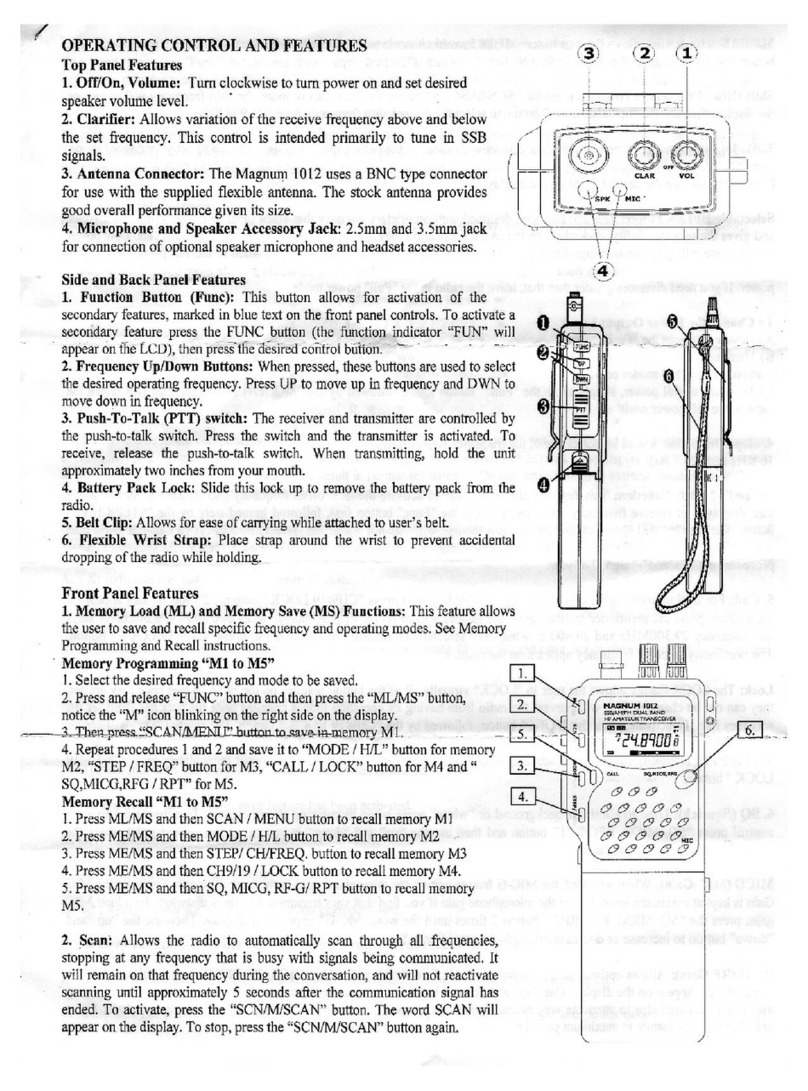
Magnum
Magnum 1012 operating instructions
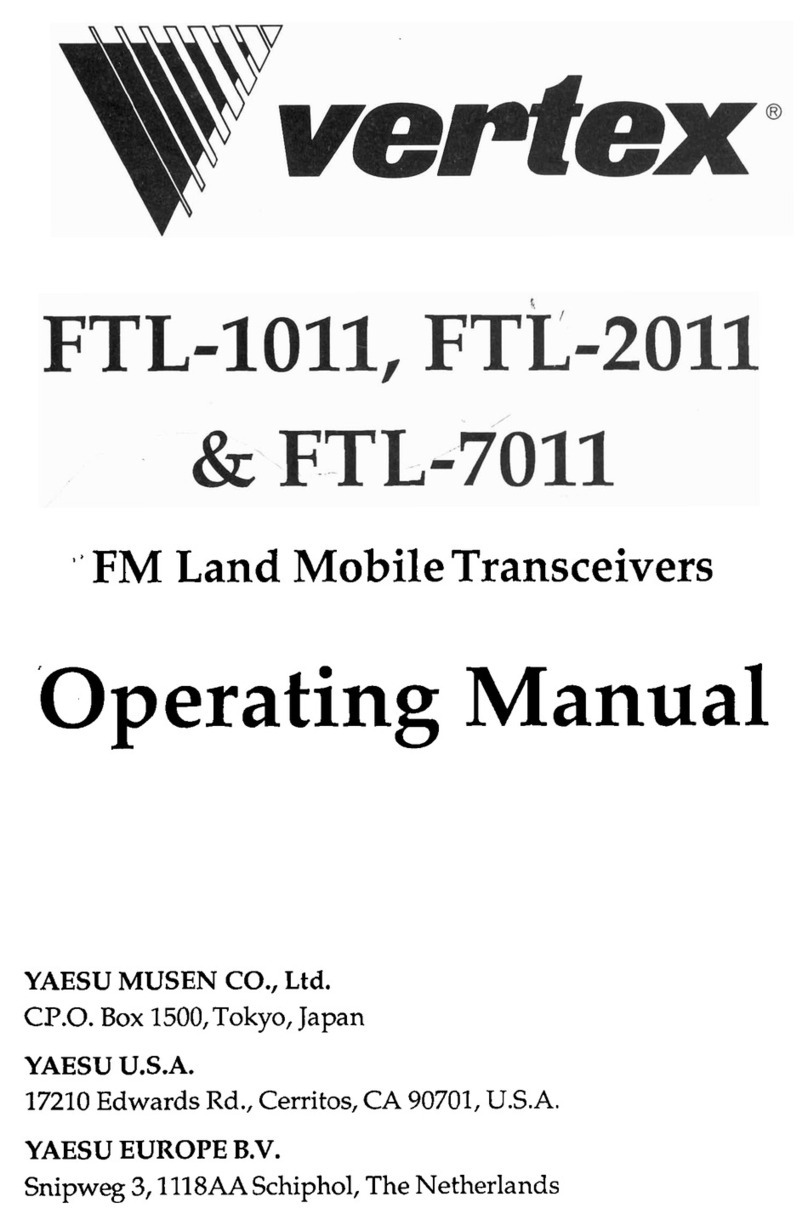
Vertex
Vertex FTL-1011 operating manual

ITALIANA SENSORI
ITALIANA SENSORI 8163-ISA023 Installation, operation and maintenance manual
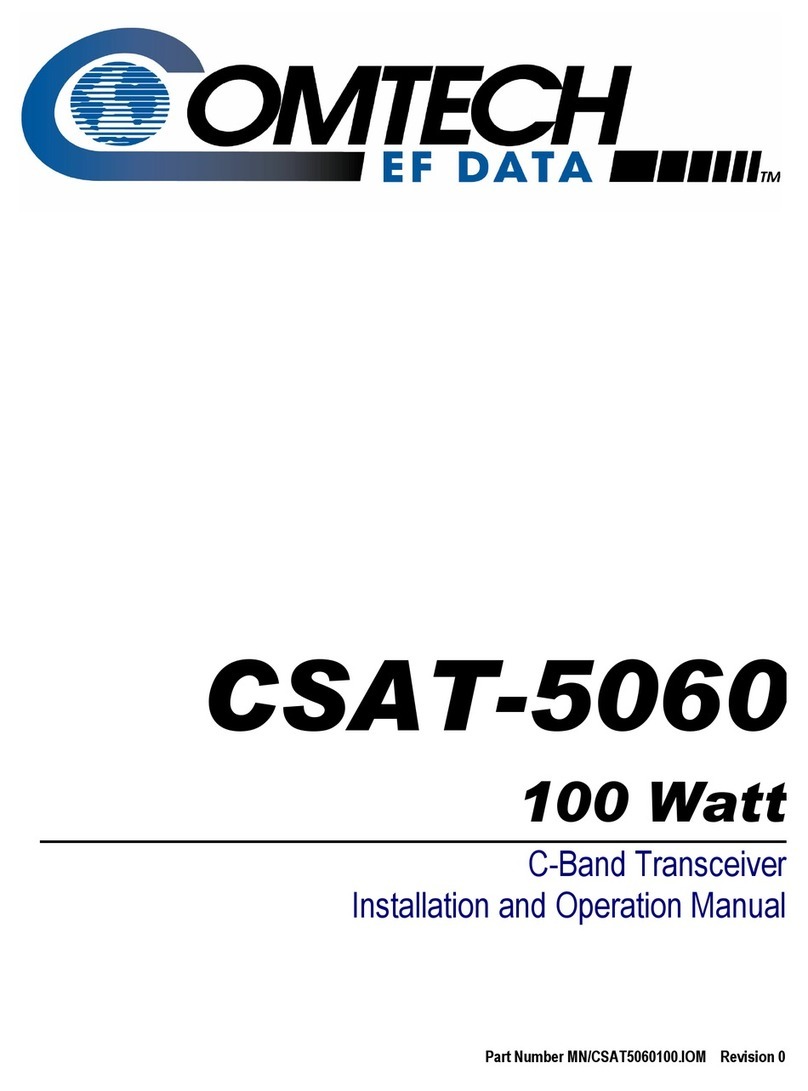
Comtech EF Data
Comtech EF Data CSAT-5060 Installation and operation manual
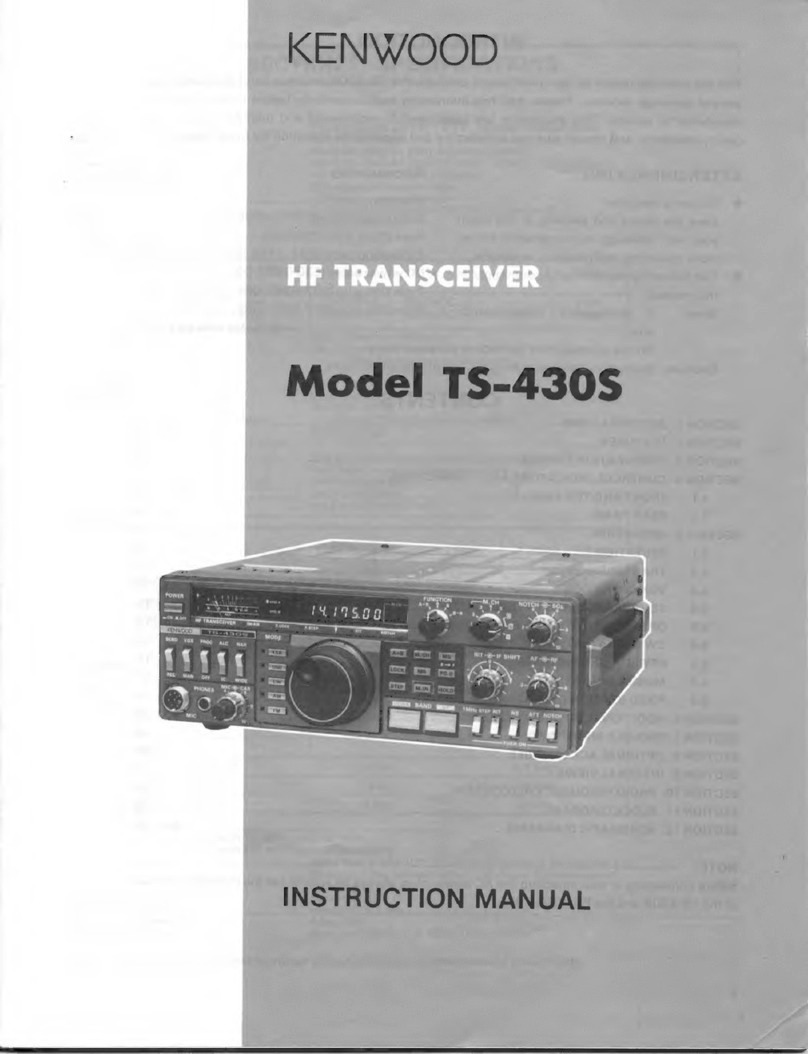
Kenwood
Kenwood TS-430S instruction manual
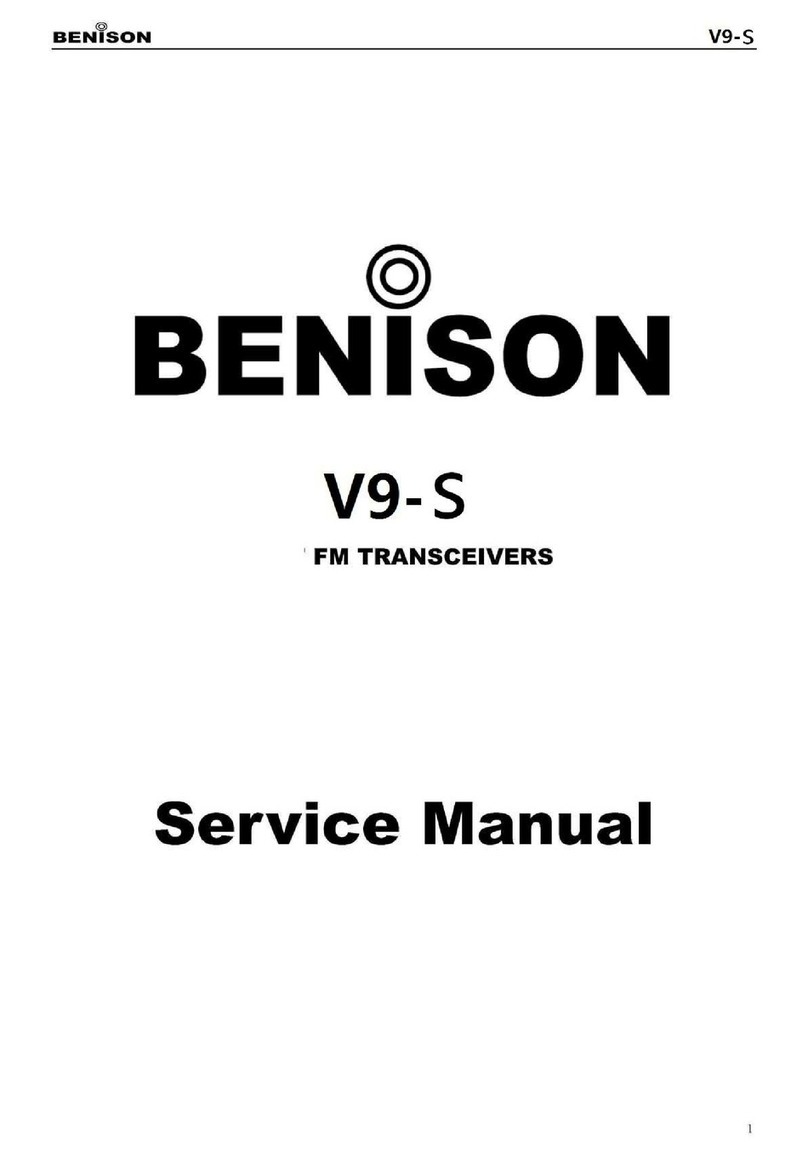
Benison
Benison V9-S Service manual
